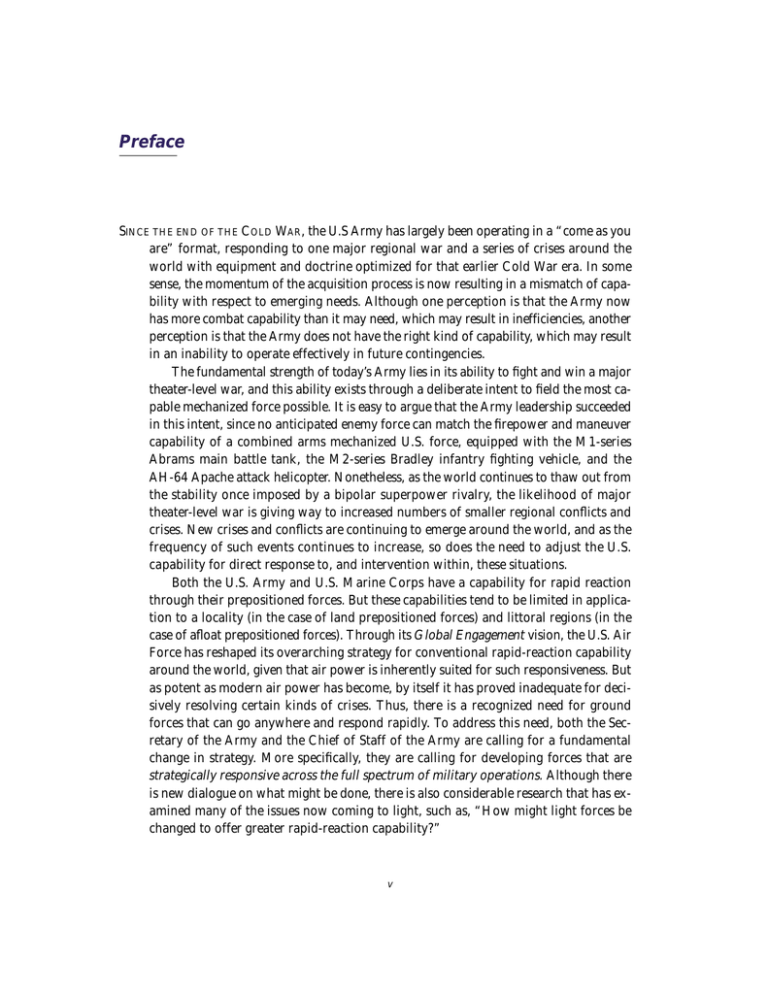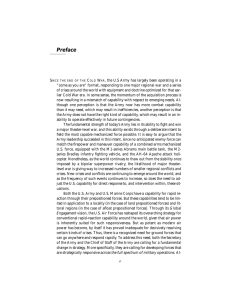Preface
advertisement

Preface SINCE THE END OF THE COLD WAR, the U.S Army has largely been operating in a “come as you are” format, responding to one major regional war and a series of crises around the world with equipment and doctrine optimized for that earlier Cold War era. In some sense, the momentum of the acquisition process is now resulting in a mismatch of capability with respect to emerging needs. Although one perception is that the Army now has more combat capability than it may need, which may result in inefficiencies, another perception is that the Army does not have the right kind of capability, which may result in an inability to operate effectively in future contingencies. The fundamental strength of today’s Army lies in its ability to fight and win a major theater-level war, and this ability exists through a deliberate intent to field the most capable mechanized force possible. It is easy to argue that the Army leadership succeeded in this intent, since no anticipated enemy force can match the firepower and maneuver capability of a combined arms mechanized U.S. force, equipped with the M1-series Abrams main battle tank, the M2-series Bradley infantry fighting vehicle, and the AH-64 Apache attack helicopter. Nonetheless, as the world continues to thaw out from the stability once imposed by a bipolar superpower rivalry, the likelihood of major theater-level war is giving way to increased numbers of smaller regional conflicts and crises. New crises and conflicts are continuing to emerge around the world, and as the frequency of such events continues to increase, so does the need to adjust the U.S. capability for direct response to, and intervention within, these situations. Both the U.S. Army and U.S. Marine Corps have a capability for rapid reaction through their prepositioned forces. But these capabilities tend to be limited in application to a locality (in the case of land prepositioned forces) and littoral regions (in the case of afloat prepositioned forces). Through its Global Engagement vision, the U.S. Air Force has reshaped its overarching strategy for conventional rapid-reaction capability around the world, given that air power is inherently suited for such responsiveness. But as potent as modern air power has become, by itself it has proved inadequate for decisively resolving certain kinds of crises. Thus, there is a recognized need for ground forces that can go anywhere and respond rapidly. To address this need, both the Secretary of the Army and the Chief of Staff of the Army are calling for a fundamental change in strategy. More specifically, they are calling for developing forces that are strategically responsive across the full spectrum of military operations. Although there is new dialogue on what might be done, there is also considerable research that has examined many of the issues now coming to light, such as, “How might light forces be changed to offer greater rapid-reaction capability?” v vi L I G HTN I N G OVE R W ATE R This book represents a compilation of research drawn from numerous studies conducted by the authors in the past few years on the topic of improving light airdeployable forces. The focus is on the topic of new operational concepts along with the underlying enabling technologies. Three very different means for improving rapidreaction capability are considered and analyzed in detail, with both strengths and weaknesses included in the assessment. This book was written primarily for the soldiers who will be developing such future capabilities; however, policymakers and technologists involved in improving rapid-reaction capability should also find it of interest. Information used to support this book was taken from research conducted by the authors for the following sponsors: the Defense Science Board (DSB) with GEN (ret.) David Maddox and Dr. Donald Latham; the Office of the Secretary of the Army for Research, Development, and Acquisition (SARDA) with Dr. A. Fenner Milton; the Defense Advanced Research Projects Agency (DARPA) with Dr. David Whelan; and U.S. Army Training and Doctrine Command (TRADOC) with MG Robert Scales, Jr. The research projects were conducted within the Force Development and Technology Program of RAND Arroyo Center and the Acquisition and Technology Policy Center of RAND’s National Defense Research Institute (NDRI). Both the Arroyo Center and NDRI are federally funded research and development centers, the first one sponsored by the United States Army, the second one sponsored by the Office of the Secretary of Defense, the Joint Staff, the unified commands, and the defense agencies. Questions about this book can be forwarded to: John Matsumura 1700 Main Street Santa Monica, CA 90407 e-mail: John_Matsumura@rand.org

